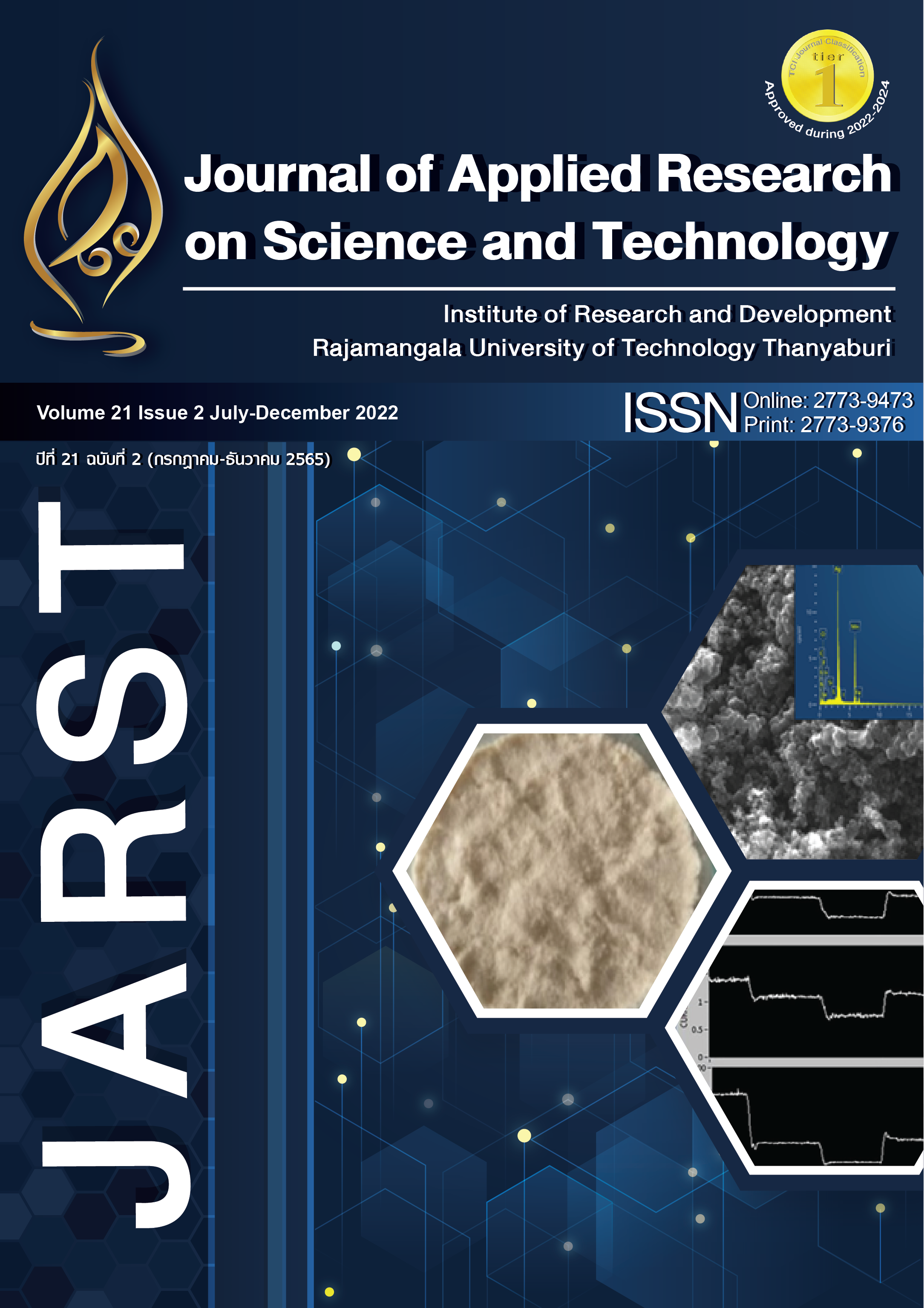Utilization of Oyster Shell as Coarse Aggregate in Concrete
Main Article Content
Abstract
This research aims to study the feasibility of using stone dust (SD) to substitute fine aggregate at 100 wt% and oyster shell waste (OSW) partial coarse aggregates replacement at 25, 50, 75, and 100 wt% to produce concrete. The ratio of cement : fine aggregate : coarse aggregates was 1:2:4 wt%. The properties of concretes such as compressive strength at 7, 14, 21, and 28 days, water absorption capacity, and unit weight of concrete at 28 days were investigated. The result showed that the compressive strength of concrete decreased with an increasing rate of OSW replacement while water absorption of concrete increased led to unit weight of concrete decreased. When the values were compared with the Thai Industrial Standards Institute TISI.213-2560 STANDARD FOR READY–MIXED CONCRETE, which met the minimum specification of concrete (than 18 MPa) at 28 days. The results indicated that OSW25 and OSW50 concrete were met the minimum specification. In terms of the production cost, SD to substitute fine aggregate at 100 wt% and OSW partial coarse aggregates replacement at 25, 50 wt% reductions in the material cost by 23–31% when compared with CT concrete.
Article Details

This work is licensed under a Creative Commons Attribution-NonCommercial-NoDerivatives 4.0 International License.
References
Fishery Statistics Analysis and Research Group. Statistics of Marine Shellfish Culture Survey 2020. Information and Communication Technology Center, Department of Fisheries, Ministry of Agriculture and Cooperatives [Internet]. [cited 2022 APR 15]. Availability from: https://www4.fisheries.go.th/local/pic_ctivities/202112281421011_pic.pdf. Thai.
Yao Z, Xia M, Li H, Chen T, Ye Y, Zheng H. Bivalve shell: not an abundant useless waste but a functional and versatile biomaterial. Crit Rev Environ Sci Technol. 2014;44(22): 2502-30.
Li G, Xu X, Chen E, Fan J, Xiong G. Properties of cement-based bricks with oyster-shells ash. J Clean Prod. 2015;(91):279-87.
Olivia M, Mifshella AA, Darmayanti L. Mechanical properties of seashell concrete. Proced Eng. 2015;(125):760-4.
Djobo YJN, Elimbi A, Manga JD, Ndjock IDL. Partial replacement of volcanic ash by bauxite and calcined oyster shell in the synthesis of volcanicash-based geopolymers. Constr Build Mater. 2016;(113):673-81.
Ez-Zaki H, Diouri A, Kamali-Bernard S, Sassi O. Composite cement mortars based on marine sediments and oyster shell powder. Mater Constr. 2016;66(321):e080.
Klathae T, Horpet P. Compressive strength and autogenous shrinkage properties of cement paste containing ground oyster shell. Thai Journal of Science and Technology. 2019;27 (4):752-63. Thai.
Yoon G. L, Kim B. T, Kim B. O, Han S. H. Chemical–mechanical characteristics of crushed oyster-shell. Waste Manage. 2003;23:825–34.
Barnaby C. An Investigation into the reuse of organic waste produced by the New Zealand Mussel Industry [Doctoral dissertation]. Auckland: Auckland University of Technology; 2004.
Yoon H, Park S, Lee K, Park J. Oyster shell as substitute for aggregate in mortar. Waste Manag Res. 2004;22(3):158-70.
Yang EI, Yi ST, Leem YM. Effect of oyster shell substituted for fine aggregate on concrete characteristics: Part I. Fundamental properties Cem Concr Res. 2005;35(11):2175-82.
Ballester P, Mármol I, Morales J, Sánchez L. Use of limestone Obtained from waste of the mussel cannery industry for the production of mortars. Cem Concr Res. 2007;37(4):559-64.
ASTM C150. American Society for Testing and Materials. Standard Specification for Portland Cement. Annual Book of ASTM Standard 4(1). PA, USA. 2015.
Tam VY, Gao XF, Tam CM. Comparing Performance of Modified Two-stage Mixing Approach for Producing Recycled Aggregate Concrete. Mag. Concr. Res. 2006;58(7):477-84.
Khankhaje E, Rafieizonooz M, Salim M.R, Mirza J, Salmiati M.W, Hussin. Comparing the effects of oil palm kernel shell and cockle shell on properties of pervious concrete pavement. Int J Pavement Res. Technol. 2017;10(5):383–92.
Khankhaje E, Salim MR, Mirza J, Hussin, Salmiati MW, Khan R, Rafieizonooz M. Properties of quiet pervious concrete containing oil palm kernel shell and cockle shell. Appl. Acoust. 2017;122:113–20.
Martínez-García C, González-Fonteboa B, Martínez-Abella F, Carro-López D. Performance of mussel shell as aggregate in plain concrete. Constr Build Mater. 2017;139:570–83.
Nguyen DH, Boutouil M, Sebaibi N, Leleyter L, Baraud F. Valorization of seashell by-products in pervious concrete pavers. Constr Build Mater. 2013;49:151–60.
Agbede OI, Manasseh J. Suitability of periwinkle shell as partial replacement of river gravel in concrete, Leonardo Electron. J Pract Technol. 2009;15:59–66.
Falade F. An investigation of periwinkle shells as coarse aggregate in concrete. Build Environ. 1995;30(4):573–7.
Neville AM, Brooks JJ. Concrete Technology. 2nd ed. Essex, UK: Pearson Education; 2010.
Shetty MS, Concrete Technology: Theory and Practice, 6th ed. New Delhi, India: S. Chand; 2012.
Adewuyi AP, Adegoke T. Exploratory study of periwinkle shells as coarse aggregates in concrete works. ARPN J En Appl Sci. 2008;3 (6):1–5.
Ekop IE, Adenuga OA, Umoh AA. Strength characteristics of granite-pachimalania aurita shell concrete. Nigerian J Agric. Food Environ. 2013;9(2):9–14.
Ettu LO, Ibearugbulem OM, Ezeh JC, Anya UC. A reinvestigation of the prospects of using periwinkle shell as partial replacement for granite in concrete. Int J Eng Sci Invent. 2013; 2(3):54–9.
Siripattarapravat C. Influence of ground seashells on properties of plastering mortar [Master of Architecture and Planning]. Thammasat University; 2009. Thai.
TISI. 213-2560. Thai Industrial Standards Institute (TISI). STANDARD FOR READY–MIXED CONCRETE. Ministry of Industry, Bangkok. Thailand. 2017. Thai.


